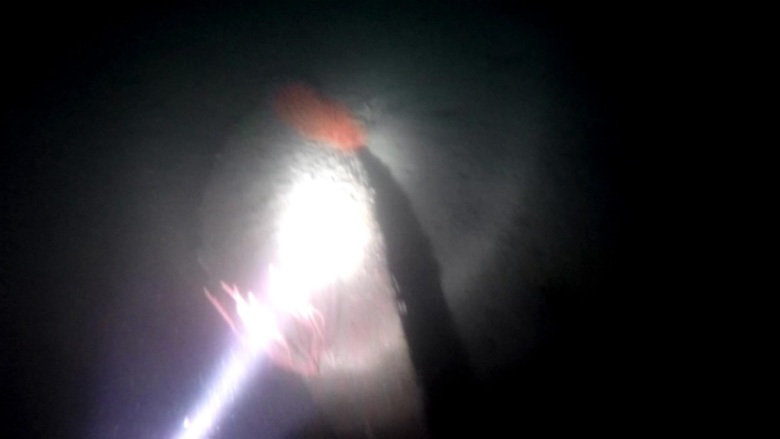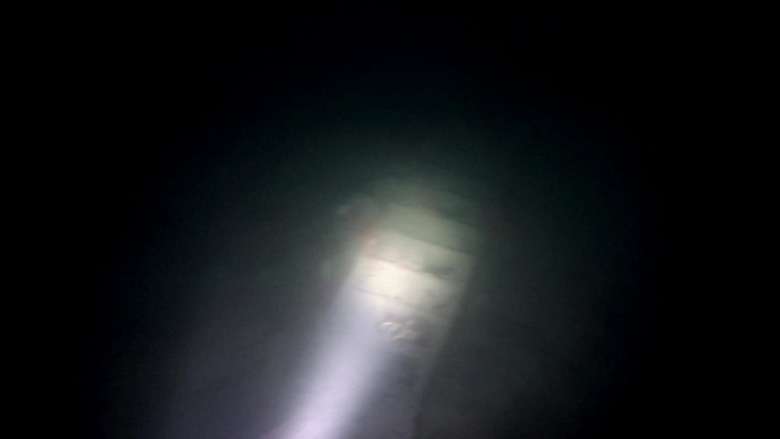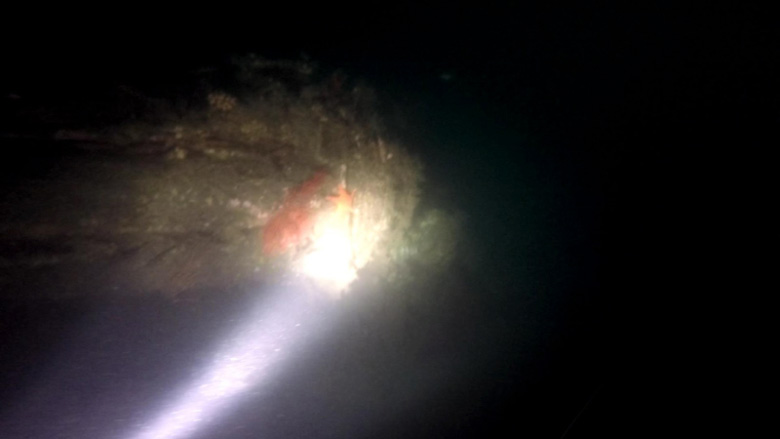On August 5, 1952, the crew of eight aboard B-36D (49-2661) were preparing to land at Lindbergh Field, San Diego, after a routine shakedown flight. Shortly after the crew had performed a required manual landing gear drop, fire broke out in the No.5 engine and it soon fell from the aircraft. The pilot banked the plane out to sea and ordered the crew to bail out. All crew members successfully exited the aircraft except for the heroic pilot. Six of the seven crew members were eventually rescued after parachuting into the sea. One crewman was never found and was presumed drowned. The aircraft was destroyed by impact and explosion. The pilot was never recovered.
Flash forward to October of 2008: Gary Fabian and the crew of the Sundiver II were searching for the plane off Mission Beach and noticed an anomaly on their side scan sonar: what appeared to be a large debris field in 255 ft of water–their video camera confirmed the rest: a Pratt & Whitney Wasp Major R-4360 Radial Engine laying on the bottom: the B-36 ‘Peacemaker’ had been found. 1
Fabian never gave out the exact location and in the intervening years, the exact location became lost, although several divers have claimed to have re-discovered the debris field, none were able to positively confirm it.
Until now.
San Diver Tech Diving Instructor Shane Thompson’s love for diving began at the age of 13 in 1985 when he was living in Safe Harbor Marina, Stock Island Florida Keys. He spent every day fishing and freediving in the Marina and often would clean boats for a bit of extra cash.
Thompson moved to Bermuda at the age of 18 in 1990. After graduating he got his certification and began working underwater construction with Nautilus Bermuda. In 1993 he joined the US Navy and was deployed to the Gulf. During his off time he picked up his Divemaster and Instructor certification. Teaching part time and helping open and manage Explorer Dive and Travel in La Jolla. In 1997 he got out of the Navy and Opened Harbor Marine diving service performing boat maintenance and salvage work.
He also taught for Aqua Tech….. and became obsessed with deep technical diving. In 2003 he sold Harbor Marine and opened Dive California. During this time he started to acquire his more advanced technical instructor qualifications. In 2004 he sold Dive California and began teaching tech diving full time as well as picking up other dive work such a salvage and insurance evidence recovery.
Since that time he has been a training director, show diver, boat captain, salvage diver, and more. He first heard of the B36 from other divers. It had become his goal and obsession to find the bomber. He spent hours researching possible locations. In 2005, divers from the San Diego Tech Divers forum started doing some exploration dives looking for the crash site. Thompson dove a site in 300 feet of water off Mission Bay that provided some interesting drop camera footage, but turned out to be a US Navy DSRV training platform.
A few months ago, Thompson began scanning the Mission Beach area for possible targets that might prove to be the bomber. He contacted his buddy Tyler Stalter, a local tech diver who was one of founders of the San Diego Tech Divers forum, who had been successful in locating other deep wrecks near San Diego. Using some of his bathymetric data, they scoured the bottom looking for possible sites. Then looking on the Internet one day, they found an article from a UDT diver who had done the destruction of the classified material on the B-36. He reported the site to be just over 250 feet deep. This, combined with the accident report stating the bomber was 3.5 miles offshore, helped them pinpointed a debris field. Descending to the bottom, on the first dive, the first thing Thompson saw was a very large propeller followed by an engine and then another. It was the thrill of a lifetime.
Thompson also noticed multiple sections of debris. He chose a central location to drop the anchor and set the hook. After his predive checks, he suited up and went over the schedule with his topside crew. After doing his in water checks and making sure his camera was recording, he started his decent. At about 230 feet he started losing light and at the bottom at 255 it was pretty dark. Once at the bottom he checked the anchor, attached his reel, and began his search. he immediately ran into a long piece of metal and determined that it was a propeller blade. The sensation was like success mixed with excitement.
Next he found one of the engines about 15 feet away, followed by bits of airframe and another engine. he found what he believed to be part of the landing gear as well as much more unrecognizable debris. He started his ascent and for the next hour and a half he anxiously waited to share his discovery. Truly the thrill of a lifetime.
Note: the original discoverer of the B-36, Gary Fabian, when shown these photos for this article, said that he believed that Mr. Thompson has, indeed, been successful in locating the B-36 plane.
Vimeo video: https://vimeo.com/135729360
_______________________________________
Story by Mike Bear
Photos by Shane Thompson, unless otherwise credited




